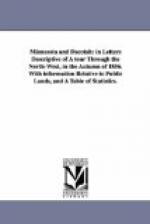“I took occasion during my visit to inquire what success the farmers met with in securing good crops, and the profits of farmers generally. As to wheat, I learned that the yield of the spring variety was quite equal in quantity and quality to the crop of that grain on any more southern farms; that in raising barley they could almost surpass the world; and the cereals generally, and all the esculent roots, were easily raised. Indian corn was not planted as a field crop, though it was grown in their gardens. In a word, the capacity of their land to produce almost everything plentifully and well, was established; but for all this, farming did not afford much profit. for want of a sufficient market; beyond a small demand by the Hudson’s Bay Company, there was no outlet for their superabundance; and to use an Austrian phase in regard to Hungarians, the Selkirkers are metaphysically ‘smothering in their own fat.’ To remedy this state of things they were beginning, when I was there, to turn their attention towards raising cattle and horses, for which their country is well calculated; and the first fruits of this new decision given to their farming energies, we have already experienced in the droves of both which have recently been driven from thence and sold in this vicinity.”
I think the facts which I have herein hastily set downhill dispel any apprehension as to the successful cultivation of the soil in the northern part of the territory. It has a health-giving climate which before long, I predict, will nourish as patriotic a race of men as gave immortality to the noble plains of Helvetia. There is one thing I would mention which seems to auspicate the speedy development of the valley of the North Red River. Next year Minnesota will probably be admitted as a state; and a new territory organized out of the broad region embracing the valley aforesaid and the head waters of the Mississippi. Or else it will be divided by a line north and south, including the western valley of that river, and extending as far to the west as the Missouri River. I understand it will be called Dacotah, though I at first thought it would be called Pembina. There is always a rush into new territories, and the proposed new territory of Dacotah will present sufficient inducements for a large immigration. When the valley of the North Red River shall be settled, and splendid harvest fields adorn its banks; when great factories take the place of wind-mills, and when railroads shall take the place of Red River carts, then we will have new cause to exclaim,
“Westward the course of empire takes its way!”
LETTER XI.
The true pioneer.
Energy of the pioneer— Frontier life— Spirit of emigration— Advantages to the farmer in moving West— Advice in regard to making preemption claims— Abstract of the preemption law— Hints to the settler— Character and services of the pioneer.




